
The large yellow underwing is a moth, the type species for the family Noctuidae. It is an abundant species throughout the Palearctic realm, one of the most common and most familiar moths of the region. In some years the species is highly migratory with large numbers appearing suddenly in marginal parts of the range.
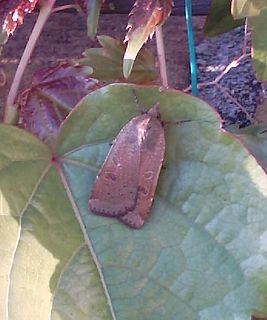
The lesser yellow underwing is a moth of the family Noctuidae.

The lesser broad-bordered yellow underwing or Langmaid's yellow underwing is a moth of the family Noctuidae. It is distributed throughout southern and central Europe, and southern Sweden.

The Aholibah underwing is a moth of the "owlet" family Erebidae, which has over 25,000 known members, and more than that yet undescribed. Like other moths of the underwing genus (Catocala), this species has dull gray and black speckled forewings which help it blend into its surroundings, and bright orange underwings that it reveals to startle predators.

Catocala is a generally Holarctic genus of moths in the family Erebidae. The genus was erected by Carl Linnaeus in his 1767 12th edition of Systema Naturae. The moths are commonly known as underwing moths or simply underwings. These terms are sometimes used for a few related moths, but usually – especially when used in plural, not as part of a species name – they are used to refer to Catocala only.

The Diana fritillary is a fritillary butterfly found in several wooded areas in southern and eastern North America. The species exhibits marked sexual dimorphism, with males of the species exhibiting an orange color on the edges of their wings, with a burnt orange underwing. Females are dark blue, with dark, almost dusty underwings, and are also larger than males.
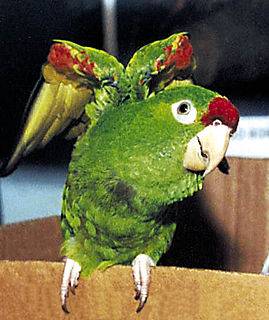
The crimson-fronted parakeet, also known as Finsch's parakeet or Finsch's conure, is a small green Neotropical parrot. It is found in Nicaragua, Costa Rica and western Panama.Its natural habitats are subtropical or tropical moist lowland forest and heavily degraded former forest.

The red-fronted lorikeet, also known as the red-spotted lorikeet or red-rumped lorikeet is a species of parrot in the family Psittaculidae. It is found in northern New Guinea and the island of Biak. Its natural habitat is subtropical or tropical moist montane forests.

The orange-cheeked parrot, also known as the Barraband's parrot, is a species of parrot in the family Psittacidae. It was formerly placed in the genus Pionopsitta, which is now monotypic.
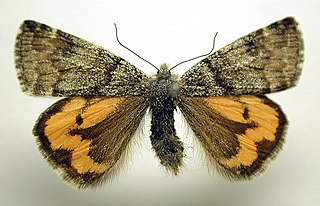
Archiearis notha, the light orange underwing, is a moth of the family Geometridae. The species was first described by Jacob Hübner in 1803 and can be found in Europe.

Archiearis parthenias, the orange underwing, is a moth of the family Geometridae. The species was first described by Carl Linnaeus in 1761 and can be found in Europe.

Catocala amestris, the three-staff underwing, is a species of Catocalini that occurs in North America. It is considered endangered and is legally protected in the state of Michigan.

Catocala ilia, the Ilia underwing, beloved underwing or wife underwing, is a moth of the family Erebidae. The species was first described by Pieter Cramer in 1776. It can be found in the eastern part of the United States as well as southern Canada. Subspecies Catocala ilia zoe can be found in California and Arizona.

Catocala junctura, the joined underwing or Stretch's underwing, is an moth in the family Erebidae. The species was first described by Francis Walker in 1858. It is found throughout temperate North America ranging from New York and Pennsylvania west to Montana, Colorado, Oklahoma, Arizona and into Texas, and north to southern Illinois, extreme southern Alberta and Saskatchewan; it has also been recorded west of the Rocky Mountains from California and south-eastern British Columbia. It is typically found near water, where the food plants of its caterpillar larvae grow plentifully.

Catocala delilah, the Delilah underwing, is a moth in the family Erebidae. The species was first described by Strecker in 1874. It is found in the southern and midwestern United States, from Ohio south to Florida and west to Texas and Oklahoma.

Euparthenos is a monotypic moth genus in the family Erebidae erected by Augustus Radcliffe Grote in 1876. Its only species, Euparthenos nubilis, the locust underwing, was first described by Jacob Hübner in 1823. The adults resemble some of the underwing moths of genus Catocala, which are fairly close relatives, in color, pattern, and the habit of resting on tree trunks. But E. nubilis can usually be immediately recognized by the four concentric black bands per hindwing, as opposed to one or two in Catocala. Color morphs of E. nubilis with altered pattern are known, however, and these may be hard to recognize without detailed examination.

Archiearis infans, the infant, is a moth of the family Geometridae. The species was first described by Heinrich Benno Möschler in 1862. It is found from Alaska to Newfoundland and the northern United States, south in the east to New Jersey, south in the west to California.
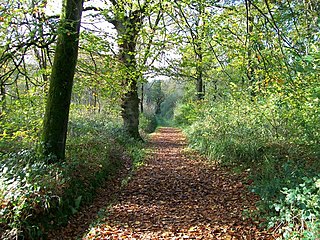
Fifehead Wood is a woodland in Dorset, England, near the village of Fifehead Magdalen. Owned and maintained by the Woodland Trust, Fifehead Wood covers a total area of 20.36 hectares, and is situated upon a ridge of Corallian Limestone within the depths of Blackmoor Vale. The name 'Fifehead' is thought to originate with an assessment made during the Domesday census of 1086, the village at that time comprising 'five hides' of land.
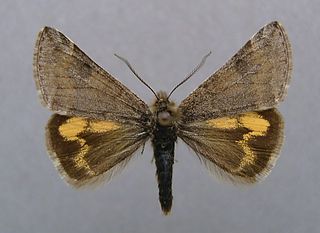
Boudinotiana puella, the pale orange underwing, is a moth of the family Geometridae. The species was first described by Eugen Johann Christoph Esper in 1787. It is found in isolated populations in central Europe, ranging to southern Russia in the east.


















